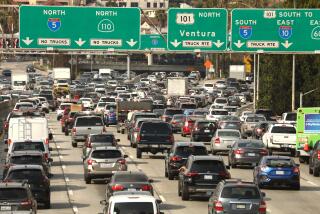Uncertain Cost Clouds Clean Air Debate : Congress: Lawmakers are forging the first major revision of the laws since 1977. Projections on the price tag for industry and consumers vary widely.
- Share via
WASHINGTON — If you believe the industrialists, the price tag attached to the sweeping clean air legislation Congress is poised to enact in coming weeks could reach $91 billion annually by the year 2005.
President Bush’s Council of Economic Advisers is more circumspect. It estimates that the most expensive sections of competing House and Senate clean air measures, forged together in a single bill, eventually would cost industry and consumers about $35 billion a year.
To this the Sierra Club, one of the nation’s largest environmental organizations, says: hogwash!
“There are three kinds of lies,” said Daniel J. Weiss, Washington director of the club’s environmental quality program. “Lies, damned lies, and industry projections about what the clean air act is going to cost.”
As House and Senate negotiators work against a mid-October deadline to produce the first major revision of the nation’s clean air laws since 1977, attention increasingly is turning toward the uncertain costs associated with the proposed clean-up of industrial smog, acid rain, auto emissions and toxic vapors.
The issue was highlighted Wednesday when one of the key clean air negotiators, Rep. John D. Dingell (D-Mich.), told an industry group that the proposed 1990 amendments to the 20-year-old Clean Air Act are likely to cost far more than official estimates indicate.
“Estimates about the cost of these legislative proposals vary greatly,” said Dingell, the House Energy and Commerce Committee chairman who is considered a friend of industry.
Referring to the “worst-case scenario” projected by the Council of Economic Advisers, Dingell said: “I suspect that cost is probably low. . . . The harsh fact of the matter is that dirty air is free, and clean air costs like hell.”
Not everyone agrees. Through a spokesman, Rep. Henry A. Waxman (D-Los Angeles), author of the House clean air bill, said: “We’re convinced that the (health and business) benefits will far outweigh the costs. The costs will be below the official estimates and in the end the Clean Air Act will actually stimulate economic growth rather than impair it.”
The cost issue is not academic. Last May, President Bush vowed to veto any clean air bill whose cost exceeds by 10% the estimated $20 billion to $21 billion annual price tag put on the Administration’s own clean air legislation, which was proposed in 1989.
“We’re waiting to see what the final product is,” a White House spokesman said. “We continue to have concerns about the overall cost of the bill.”
One congressional staff member suggested that Dingell’s remarks signal a renewed campaign by the energy and commerce chairman to keep environmental interests at bay as members of the House and Senate struggle to draft the legislation.
Another official said that Dingell’s speech underscored the extent to which the legislators who are crafting the final version of the complex bill are laboring in twilight, if not darkness, as far as the eventual expense is concerned.
“I don’t have a sense of a lot of refined understanding (about the cost issues) up there” on Capitol Hill, said the official, who asked not to be identified.
So far, House and Senate negotiators have agreed on the core of the legislation: the 300-page Title I, which is intended to dramatically reduce industrial pollution in the nation’s smoggiest cities by targeting even the smallest polluters. The measure would require industrial polluters to dramatically cut emissions of hydrocarbons and nitrogen oxides by installing smoke scrubbers and other pollution control devices.
House and Senate conferees also have agreed on Title IV, which outlines procedures for granting emission permits to a broad range of industrial and commercial polluters.
The negotiators still face tough bargaining on sections that would further reduce auto tailpipe emissions, require production of cleaner cars and fuels, restrict the burning of high sulfur coal to reduce acid rain and limit industrial emissions of toxic chemicals throughout the nation, not just in polluted areas.
The ultimate cost of these measures--which will fall almost exclusively on industry and consumers through increased prices--appears to be anyone’s guess.
A study released last month by the Clean Air Working Group, an industry organization with ties to the National Assn. of Manufacturers, estimated that the least expensive provisions of the House and Senate bills taken together eventually would cost industry and consumers $51 billion a year. The most costly provisions, if enacted in a single bill, would raise the annual price tag to $91 billion, the study concluded.
The organization quoted another study estimating that the benefits associated with the bill would amount to only $14 billion to $16 billion a year.
Those figures are strongly disputed by the Sierra Club.
“The American Lung Assn. estimates that health damage from motor vehicles alone, just one small part of the (clean air) act, comes to $40 billion to $60 billion a year,” Weiss said. “Any figures, even the most exaggerated cost figures that we’ve heard from the industry flaks, those estimates pale in comparison to the amount of damage caused by air pollution in this country.”
One member of the Council of Economic Advisers, which has estimated the annual price tags for the Administration’s bill at $20 billion to $21 billion and the separate House and Senate bills at about $25 billion each, said that he has trouble with industry’s numbers.
“We’ve had a hard time understanding how the Clean Air Working Group could simultaneously cost the President’s proposal at $21 billion and the House and Senate bills at $18 quintrillion,” said council member Richard Schmalensee.
More to Read
Get the L.A. Times Politics newsletter
Deeply reported insights into legislation, politics and policy from Sacramento, Washington and beyond. In your inbox twice per week.
You may occasionally receive promotional content from the Los Angeles Times.










